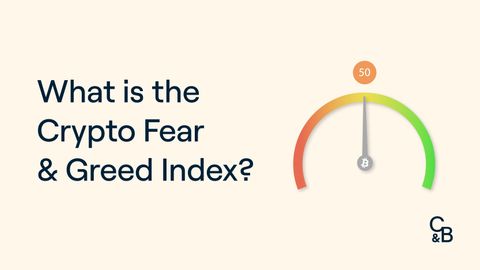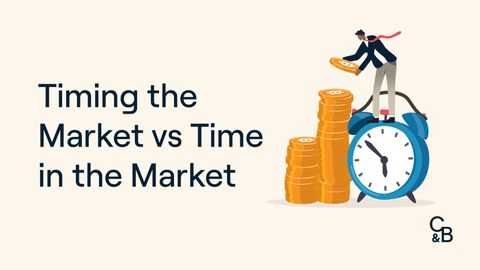In November 2021, the total cryptocurrency market capitalisation surpassed $3 trillion.
Yes, that’s a huge number. But without the context, what does it really mean? Is it an indicator of any historical trend, growth potential, or actual dollar amount?
Let’s dive into the most commonly touted crypto statistic: market cap. We’ll discuss what it really means, how it’s calculated, and how this metric could help you make decisions on future crypto investments.
- Definition:
- What is Market Cap in Crypto?
- How is Market Cap Calculated?
- Difference Between Small, Mid, & Large-Cap Cryptocurrencies
- Market Cap vs. Cash Inflow
- Other Metrics & Ways to Evaluate Cryptocurrencies
- Market Cap vs Volume
- Top 10 Cryptos by Market Cap**
- Market Cap FAQs
- Start Building Your Crypto Portfolio with Caleb & Brown
Definition:
In the crypto market, market capitalisation (market cap) is the total dollar value of all coins in circulation. Market cap can be used to measure the value of a specific cryptocurrency, as well as refer to the total capitalisation of all cryptocurrencies in existence.
What is Market Cap in Crypto?
Market cap is a metric used to help traders and investors understand the value or value potential of a particular cryptocurrency. It’s a concept with roots in traditional investing, where market cap is used to quantify the dollar value of shares in circulation for a company.
The size of a market cap can help investors make inferences about the risk profile of a coin, its potential for long-term growth, and its market dominance.
How is Market Cap Calculated?
There are two common ways to express cryptocurrency market cap: circulating supply or fully diluted supply. Market cap can be calculated by using the number of coins currently in circulation (circulating supply). Or it can be calculated using the number of coins that will be in circulation once the limit is reached (full diluted supply).
Given that this serves mainly as a tool for making investment decisions in the present, circulating supply is almost exclusively used when calculating market cap. This is determined by the following formula:
Current Price x Circulating Supply = Market Cap
Difference Between Small, Mid, & Large-Cap Cryptocurrencies
When using market cap to discuss cryptocurrencies, they are generally divided into three categories: small, mid, and large-cap.
Small-cap cryptocurrencies
Small-cap cryptocurrencies tend to have market caps under $1 billion. Compared to other coins, they usually have less exchange support, lower volume, or both. For this reason, small market movements can create volatile swings for these small-cap cryptocurrencies.
Mid-cap cryptocurrencies
Mid-cap cryptocurrencies have capitalisations between $1 billion and $10 billion. Traders often look to mid-cap coins to predict growth potential. Yet since these cryptocurrencies haven’t established large-cap positioning, there is still a greater level of risk involved.
Large-cap cryptocurrencies
Large-cap cryptocurrencies with capitalisations of more than $10 billion. These are your ‘household name’ coins; Bitcoin, Ethereum, XRP, and more. These cryptocurrencies have a relatively higher trading volume compared to other crypto assets.

Why Are Large-Cap Cryptocurrencies Considered to Have Lower Risk Profile?
It goes without saying that cryptocurrency investments are more often than not more volatile than stocks or any other traditional investments. But some investors see large-cap cryptos as a sign of stability within a volatile market. The large-cap coins which have shown growth over time (not overnight growth) usually have high liquidity.
So if many investors decide to market sell, you will probably see less slippage than a small or mid-cap market sell.
Market Cap vs. Cash Inflow
Since market cap is expressed as a dollar amount, it can be misconstrued as cash inflow. Market cap is not a measure of the amount of money in the market.
Popularity, volume, liquidity, and many other factors can affect the price of a coin. If this price changes in any way, the market cap will reflect that change. This is one of the reasons why market caps can fluctuate by millions of dollars daily.
Other Metrics & Ways to Evaluate Cryptocurrencies
While market cap is important, you shouldn't just use this number to evaluate a potential investment. Below is a list of other things to consider while doing your research.
- What is the project solving? i.e. Is there utility?
- Do the values of this project align with my values?
- What is the overall project ranking?
- Read the project white paper, is there anything about the project that seems questionable? (e.g. lack of real-world case use, issues with legality)
- Price History
- Liquidity
- Volume
Further reading: The Bitcoin White Paper
Market Cap vs Volume
The relationship between market cap and volume can be speculative. Although one can influence the other in different ways, these influences aren’t an exact science.
If a coin’s 24-hour trading volume exceeds its market cap in a given period, it could mean investors are speculating about its potential growth. It could mean something, or it could be a temporary trend.
Conversely, Bitcoin has a low trading volume when compared to its market cap (still a high volume otherwise). But since there is less action happening, it doesn’t mean that Bitcoin is losing value. We can probably infer that short-term holders (STHs) are becoming long-term holders (LTHs), reducing the overall liquid supply of Bitcoin.
Top 10 Cryptos by Market Cap**
(as of October 23, 2023)
- Bitcoin (BTC) at $1.3T
- Ethereum (ETH) at $420B
- Tether (USDT) at $104B
- Binance (BNB) at $87B
- Solana (SOL) at $79B
- XRP (XRP) at $35B
- USD Coin (USDC) at $32B
- Cardano (ADA) at $22B
- Dogecoin (DOGE) at $22B
- Avalanche (AVAX) at $20B
Market Cap FAQs
(statistics up to date as of March 22, 2024)
What is the current crypto market cap?
$2,600,000,000,000
Why is crypto market cap important?
In a market fueled by social media trends, fear, and greed, market cap adds a level of objectivity to determining the value of a cryptocurrency.
Recommended reading: What Is the Crypto Fear and Greed Index?
What is the highest crypto market cap ever?
The total market cap reached an all-time high of $3 trillion in November 2021 (Fortune).
How do you calculate crypto market cap?
Current Price x Circulating Supply = Market Cap
What is Bitcoin’s market cap?
$1,300,000,000,000
What is Ethereum’s market cap?*
$420,000,000,000
Start Building Your Crypto Portfolio with Caleb & Brown
Understanding how market cap works can give you some insight into what cryptocurrencies might best fit your investing strategy. Having this knowledge on hand is crucial in building your objectivity as an investor.
For more crypto reads like this one, check out our blog.
And if you’re ready to start investing, our brokers are here to help you get started.
Disclaimer: This assessment does not consider your personal circumstances, and should not be construed as financial, legal or investment advice. These thoughts are ours only and should only be taken as educational by the reader. Under no circumstances do we make recommendation or assurance towards the views expressed in the blog-post. The Company disclaims all duties and liabilities, including liability for negligence, for any loss or damage which is suffered or incurred by any person acting on any information provided.






